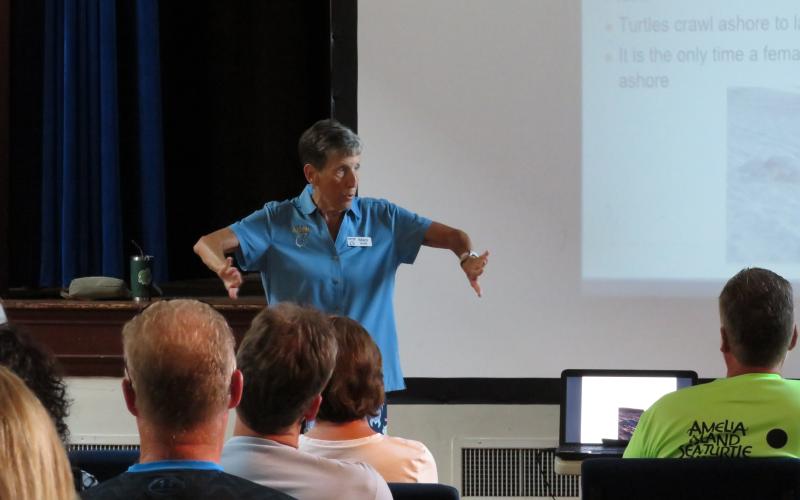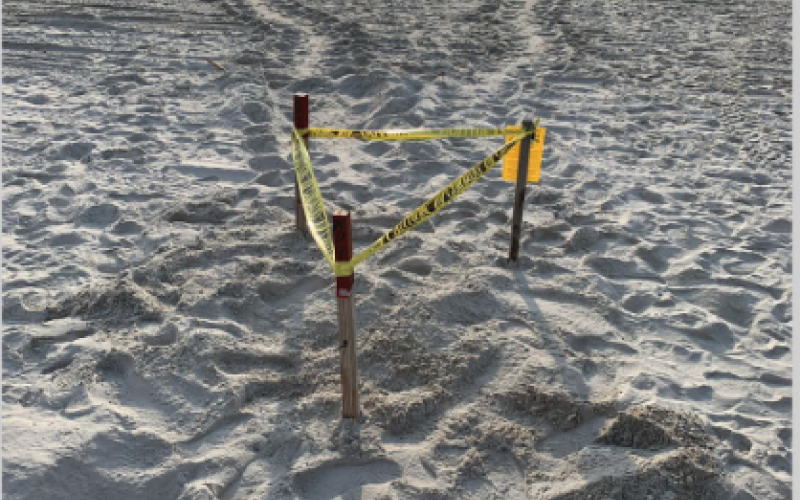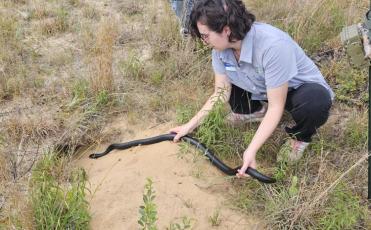A summer staple on Florida’s coasts, the sea turtles are preparing to return, and the Amelia Island Sea Turtle Watch is ready to face it head-on.
The turtle watch met Tuesday night for its first meeting of the season to give an introductory training for new and veteran volunteers. With more than 30 years of experience under her belt, turtle watch president Mary Duffy led the meeting.
“We’re data collectors,” Duffy told the audience. “We just have a lot of fun doing it.”
Since its organization in 1985, the turtle watch has marked and watched over countless nests along Amelia Island’s beaches (last year alone saw more than 220 nests and 24,000 eggs on the island, as reported by the turtle watch). Regular walkers with the turtle watch walk up and down their assigned section of the beach with their eyes open for turtle tracks at civil twilight, 20 minutes before sunrise. Trained to identify tracks and the species they come from, walkers take pictures and send them to Duffy, so she can arrange for permitted volunteers to mark the nest.
Permitted volunteers participate in training from the Florida Fish and Wildlife Conservation Commission and the U.S. Fish and Wildlife Service.
At the meeting, Duffy explained how to identify nests and false crawls. False crawls happen when female turtles crawl up onto the beach with the intention of nesting but turn around without doing so. Duffy also showed the audience examples of the three different kinds of nests found on Amelia Island – those from loggerhead, green and leatherback turtles.
The majority of nests come from loggerheads. The last leatherback turtle nest on the island was in 2019.
The turtle watch will mark its eighth year of testing in 2023. Permitted volunteers will take an egg from a nest and send it off for genetic testing, which allows researchers to track the mother turtles over several years. Sea turtles can live to be more than 50 years old and will nest several times over the course of one season. Testing can show where and how often specific turtles nest.
All five species of sea turtle in Florida are under the protection of the Endangered Species Act. The act protects sea turtles and their environment to ensure their survival. Humans are generally considered the largest threat to sea turtles’ survival. Things like improper lighting on beachfront property, beach furniture left out over night and holes left in the sand can all harm turtles.
The average sea turtle nest will hold about 100 eggs. Of the hatchlings, only about 2% will make it to adulthood. Ensuring the beach is dark, clean and flat is key to protecting them.
Hatchlings’ instinct to follow the light when they emerge from the nest at night is thrown off by bright lights leading them away from the beach. Too long out of water, and they die of dehydration. Beach furniture and holes in the sand make it even more difficult for female turtles to safely crawl ashore and nest.
“They’re the barometer of the ocean,” Duffy said about the importance of protecting sea turtles. “When the sea turtles start dying, that means the ocean is dying. The ocean spits out what it doesn’t want. So when dead turtles, dead dolphins, dead whales start washing ashore, that’s an indication that there’s something seriously wrong with the ocean.”
The Amelia Island Sea Turtle Watch will begin its regular beach walks May 1 and will continue through the end of August. Any hatchlings and nest disturbances, including vandalism or injured or dead turtles, should be reported to the turtle watch.
hdorman@fbnewsleader.com





